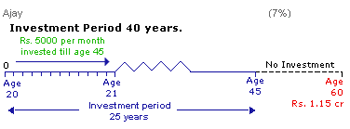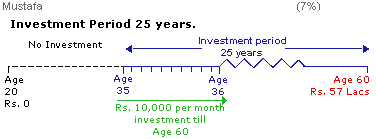|
The principal of time value of money (“TVM”) applies here. Let us start with an example first. Two friends, Ajay, and Mustafa are 20 years old. Ajay decides that he wants to start investing his money early to build himself a secure future and decides to save Rs. 5,000 monthly (i.e. Rs. 60,000 per annum) at the age of 20. Mustafa feel that he is young and wants to enjoy his money for the time being. Mustafa wakes up late and decides to invest at the age of 35 years and decides to save Rs. 10,000 per month (i.e. Rs. 1,20,000 per annum). At the age of 60 years when they want to retire, using an interest rate of 7% per annum, Ajay who had invested Rs. 5,000 monthly for 25 years has Rs. 1.15 cr. and Mustafa who had invested Rs. 10,000 monthly for the same amount of time has Rs. 57 lacs. Please refer to the illustrations below for a better understanding.


The nuclear weapon in your arsenal for your fight against Risk. It simply means that you must spread your investment across different securities (stocks, bonds, money market instruments, real estate, fixed deposits etc.) and different sectors (auto, textile, information technology etc.). This kind of a diversification may add to the stability of your returns, for example during one period of time equities might under perform but bonds and money market instruments might do well enough to offset the effect of a slump in the equity markets. Similarly the information technology sector might be faring poorly but the auto and textile sectors might do well and may protect you principal investment as well as help you meet your return objectives.
| Inflation – Do not invest too conservatively |
Things you hear people talk about:
“Rs. 100 today is worth more than Rs. 100 tomorrow.”
“Remember the time when a bus ride costed 50 paise ?”
“Mehangai Ka Jamana Hai.”
The root cause, Inflation. Inflation is the loss of purchasing power over time. A lot of times people make conservative investment decisions to protect their capital but end up with a sum of money that can buy less than what the principal could at the time of the investment. This happens when inflation grows faster than the return on your investment. A well-diversified portfolio with some investment in equities might help mitigate this risk.
More often than not we find investors buying stocks in companies suggest by their friends, while not knowing what the company does or how it is performing. The aim - to make a quick buck. The result – they may probably lose their money. We believe in buying value, it is imperative that you either do your homework or hire a professional financial advisor to do it for you. Buying and holding undervalued securities is the probably the best way to beat the market.
This depends on your cash requirements. If you feel that you might need the funds that your are investing say sometime in the near future you might consider investing in liquid assets or plan your cash flows accordingly. Higher liquidity translates into lower returns and consequently lower risk.
This technique helps you make volatility in the financial markets work for you. Let us start with an example:
|
Month
|
Investment Amount (Rs.)
|
Unit Price (Rs.)
|
No. of Units
|
|
1
|
1,000
|
10.00
|
100.00
|
|
2
|
1,000
|
11.00
|
90.91
|
|
3
|
1,000
|
12.00
|
83.33
|
|
4
|
1,000
|
9.00
|
111.11
|
|
5
|
1,000
|
8.00
|
125.00
|
|
Total
|
5,000
|
10.00 / 9.801*
|
510.35
|
(* Rs. 10.00 is the average sales price achieved by taking an average of all of the sales prices. Rs. 9.80 is the average cost per unit arrived to by dividing the total amount invested by the number of units bought.)
As you see from the example above that even though you buy units at the higher prices of Rs.11 and Rs. 12 per unit your average cost per unit still remains at Rs. 9.80 per unit since you have the chance to buy addition units at lower prices as well. The amount invested per month has to be the same for this to work since you end up buying more units when the price is low and fewer units when the price is high, only then will your average cost per unit (Rs. 9.80) remain below your average sale price (Rs. 10). Please note that Rupee Cost Averaging does not protect against loss in a declining market scenario.
|



